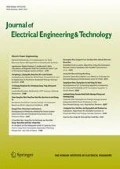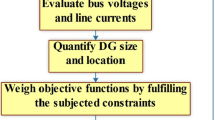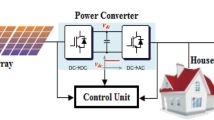Abstract
This paper presents a new optimization tool-based population parameter called Harris hawks optimizer (HHO) and its application study to fine-tune the gains of well-designed proportional-derivative proportional-integral (PD-PI) cascade control to suppress the load frequency control (LFC) issues. The HHO based PID and PD-PI controllers are broadly implemented at two models with many circumstances for each model to ensure the effectiveness and the robustness of the proposed scheme at a high load disturbance, nonlinearity, and some critical parameters associated with the interconnected power system. First, a two-area non-reheat power plant is implemented, and the gains of PID and PD-PI controllers are adjusted using the proposed algorithm. In order to introduce extra realistic challenges, the governor-dead band is also modeled to ensure the robustness of the HHO/PD-PI in handling nonlinearity properties. Furthermore, to guarantee the suitability of the proposed HHO/PD-PI, a model with a mixture of power plants is carried out with and without the HVDC link, which is raised for the practical problems of LFC. Simulation results proved that; the proposed techniques HHO/PID and HHO/PD-PI provide superior performance compared to other reported strategies such as DE/PID, TLBO/PID, IGWO/PID, multi-objective/PID, and TLBO/2DOF-PID controllers. Finally, the dynamic investigation has also been completed using the random load pattern in system model-2, which shows the superior performance of HHO/PID and HHO/PD-PI schemes.
















Similar content being viewed by others
Abbreviations
- i :
-
Subscript associated to area (i = 1, 2)
- f :
-
Nominal frequency (Hz)
- P R :
-
Area \(\mathrm{rated}\) power (MW)
- P L :
-
Nominal operative load (MW)
- \(\Delta f_{i}\) :
-
Frequency deviations (Hz)
- \(\Delta P_{Li}\) :
-
Step load change
- \(\Delta P_{tie}\) :
-
Tie-line deviation of power (p.u.)
- B i :
-
Frequency bias (p.u. MW/Hz)
- R i :
-
Speed regulation (Hz/p.u.)
- T ti :
-
Steam turbine time constant (s)
- T gi :
-
Speed governor time constant (s)
- T 12 :
-
Synchronizing coefficient (p.u.)
- T RSi :
-
Hydro turbine speed governor reset time (s)
- T GHi :
-
Hydro turbine speed governor time constant (s)
- T RHi :
-
Hydro turbine speed governor transient droop time constant (s)
- T Wi :
-
Nominal initial time of water in penstock (s)
- K Ri :
-
Reheat coefficient of steam turbine
- T ri :
-
Reheat time constant of steam turbine (s)
- K pSi :
-
Power system gain (Hz/p.u.)
- T PSi :
-
Power system time constant (s)
- K T :
-
Contribution factors of thermal unit
- K H :
-
Contribution factors of hydro unit
- K G :
-
Contribution factors of gas unit
- K DC :
-
HVDC gain of power system (Hz/p.u.)
- T DC :
-
HVDC time constant (s)
- b g :
-
Gas turbine constant of positioner (s)
- c g :
-
Gas turbine valve positioner
- Y C :
-
Lag time of gas turbine governor (s)
- X C :
-
Lead time of gas turbine governor (s)
- T fi :
-
Gas turbine fuel time constant (s)
- T CDi :
-
Gas turbine compressor discharge volume time constant (s)
- T CRi :
-
Gas turbine combustion reaction time delay (s
References
Kundur P, Balu NJ, Lauby MG (1994) Power system stability and control, vol 7. McGraw-hill, New York
Elgerd OI (1982) Electric energy systems theory: an introduction
Bevrani H (2014) Robust power system frequency control
Ray PK, Mohanty SR, Kishor N (2011) Proportional–integral controller based small-signal analysis of hybrid distributed generation systems. Energy Convers Manag 52(4):1943–1954
Thirunavukarasu R, Chidambaram IA (2016) PI2 controller based coordinated control with Redox Flow Battery and Unified Power Flow Controller for improved Restoration Indices in a deregulated power system. Ain Shams Eng J 7(4):1011–1027
Alhelou HH, Hamedani-Golshan M-E, Zamani R, Heydarian-Forushani E, Siano P (2018) Challenges and opportunities of load frequency control in conventional, modern and future smart power systems: a comprehensive review. Energies 11(10):2497
Yousef H (2015) Adaptive fuzzy logic load frequency control of multi-area power system. Int J Electr Power Energy Syst 68:384–395
Hosseini SH, Etemadi AH (2008) Adaptive neuro-fuzzy inference system based automatic generation control. Electr Power Syst Res 78(7):1230–1239
Rao CS (2012) Adaptive neuro fuzzy based load frequency control of multi area system under open market scenario. In: IEEE-international conference on advances in engineering, science and management (ICAESM-2012), pp 5–10
Abdel-Magid YL, Dawoud MM (1995) Genetic algorithms applications in load frequency control
Wrate CA, Wozniak L (1997) Hydrogenerator system identification using a simple genetic algorithm. IEEE Trans Energy Convers 12(1):60–65
Kumari N, Jha AN (2014) Frequency control of multi-area power system network using PSO based LQR. In: 2014 6th IEEE Power India International Conference (PIICON), pp 1–6
Guha D, Roy PK, Banerjee S (2018) Maiden application of SSA-optimised CC-TID controller for load frequency control of power systems. IET Gener Transm Distrib 13(7):1110–1120
Mohanty B, Panda S, Hota PK (2014) Controller parameters tuning of differential evolution algorithm and its application to load frequency control of multi-source power system. Int J Electr Power Energy Syst 54:77–85
Ali ES, Abd-Elazim SM (2013) BFOA based design of PID controller for two area load frequency control with nonlinearities. Int J Electr Power Energy Syst 51:224–231
Barisal AK (2015) Comparative performance analysis of teaching learning based optimization for automatic load frequency control of multi-source power systems. Int J Electr Power Energy Syst 66:67–77
Sahu RK, Panda S, Rout UK, Sahoo DK (2016) Teaching learning based optimization algorithm for automatic generation control of power system using 2-DOF PID controller. Int J Electr Power Energy Syst 77:287–301
Fini MH, Yousefi GR, Alhelou HH (2016) Comparative study on the performance of many-objective and single-objective optimisation algorithms in tuning load frequency controllers of multi-area power systems. IET Gener Transm Distrib 10(12):2915–2923
Topno PN, Chanana S (2018) Load frequency control of a two-area multi-source power system using a tilt integral derivative controller. J Vib Control 24(1):110–125
Simhadri KS, Mohanty B, Panda SK (2019) Comparative performance analysis of 2DOF state feedback controller for automatic generation control using whale optimization algorithm. Optim Control Appl Methods 40(1):24–42
Franks RG, Worley CW (1956) Quantitative analysis of cascade control. Ind Eng Chem 48(6):1074–1079
Gheisarnejad M (2018) An effective hybrid harmony search and cuckoo optimization algorithm based fuzzy PID controller for load frequency control. Appl Soft Comput 65:121–138
Debnath MK, Jena T, Mallick RK (2017) Optimal design of PD-Fuzzy-PID cascaded controller for automatic generation control. Cogent Eng 4(1):1416535
Dash P, Saikia LC, Sinha N (2015) Automatic generation control of multi area thermal system using Bat algorithm optimized PD-PID cascade controller. Int J Electr Power Energy Syst 68(364–372):2015
Dash P, Saikia LC, Sinha N (2016) Flower pollination algorithm optimized PI-PD cascade controller in automatic generation control of a multi-area power system. Int J Electr Power Energy Syst 82:19–28
Padhy S, Panda S, Mahapatra S (2017) A modified GWO technique based cascade PI-PD controller for AGC of power systems in presence of plug in electric vehicles. Eng Sci Technol Int J 20(2):427–442
Jeng J-C, Liao S-J (2013) A simultaneous tuning method for cascade control systems based on direct use of plant data. Ind Eng Chem Res 52(47):16820–16831
Kumari S, Shankar G (2019) Maiden application of cascade tilt-integral–tilt-derivative controller for performance analysis of load frequency control of interconnected multi-source power system. IET Gener Transm Distrib 13(23):5326–5338
Heidari AA, Mirjalili S, Faris H, Aljarah I, Mafarja M, Chen H (2019) Harris hawks optimization: algorithm and applications. Future Gener Comput Syst 97:849–872
Abbasi A, Firouzi B, Sendur P (2019) On the application of Harris hawks optimization (HHO) algorithm to the design of microchannel heat sinks. Eng Comput 3:1–20
Yousri D, Allam D, Eteiba MB (2020) Optimal photovoltaic array reconfiguration for alleviating the partial shading influence based on a modified harris hawks optimizer. Energy Convers Manag 206:112470
Yousri D, Babu TS, Fathy A (2020) Recent methodology based Harris Hawks optimizer for designing load frequency control incorporated in multi-interconnected renewable energy plants. Sustain Energy Grids Netw 22:100352
Yuan Z, Wang W, Wang H, Yıldızbaşı A (2020) Allocation and sizing of battery energy storage system for primary frequency control based on bio-inspired methods: a case study. Int J Hydrog Energy 45:19455–19464
Crowe J et al (2005) PID control: new identification and design methods. Springer
Sahoo BP, Panda S (2018) Improved grey wolf optimization technique for fuzzy aided PID controller design for power system frequency control. Sustain Energy Grids Netw 16:278–299
Gozde H, Taplamacioglu MC (2011) Automatic generation control application with craziness based particle swarm optimization in a thermal power system. Int J Electr Power Energy Syst 33(1):8–16
Panda S, Mohanty B, Hota PK (2013) Hybrid BFOA–PSO algorithm for automatic generation control of linear and nonlinear interconnected power systems. Appl Soft Comput 13(12):4718–4730
Kaya I, Atherton DP (2005) Improved cascade control structure for controlling unstable and integrating processes. In: Proceedings of the 44th IEEE conference on decision and control, pp 7133–7138
Wang F-S, Juang W-S, Chan C-T (1995) Optimal tuning of PID controllers for single and cascade control loops. Chem Eng Commun 132(1):15–34
Salcedo-Sanz S (2016) Modern meta-heuristics based on nonlinear physics processes: a review of models and design procedures. Phys Rep 655:1–70
Sahu RK, Panda S, Biswal A, Sekhar GTC (2016) Design and analysis of tilt integral derivative controller with filter for load frequency control of multi-area interconnected power systems. ISA Trans 61:251–264
Author information
Authors and Affiliations
Corresponding author
Additional information
Publisher's Note
Springer Nature remains neutral with regard to jurisdictional claims in published maps and institutional affiliations.
Appendices
Appendix 1: Two-area two-unit power plant [15, 17, 22]
\(P_{R} = 2000{\text{ MW}};\) \(P_{L} = 1000{\text{ MW}};\) \(f = 60{\text{ H}}_{{\text{Z}}} ;\) \(B_{1} = B_{2} = 0.425 {\text{p}}.{\text{u}}.{\text{ MW}}/{\text{H}}_{{\text{Z}}}\); \(R_{1} = R_{2} = 2.4{\text{ H}}_{Z} /{\text{p}}.{\text{u}}.\); \(T_{g1} = T_{g2} = 0.08{\text{ s}}\); \(T_{t1} = T_{t2} = 0.3 s\); \(K_{PS1} = K_{PS2} = 120{\text{ H}}_{Z} /{\text{p}}.{\text{u}}.\); \(T_{PS1} = T_{PS2} = 20 {\text{ s}}\); \(T_{12} = 0.545 {\text{p}}.{\text{u}}.;{ }a_{12} = - 1.\)
Appendix 2: Two-area two-unit with governor dead band [22, 36, 37]
\(B_{1} = B_{2} = 0.425 {\text{p}}.{\text{u}}.{\text{ MW}}/{\text{H}}_{{\text{Z}}}\); \(R_{1} = R_{2} = 2.4{\text{ H}}_{Z} /{\text{p}}.{\text{u}}.\); \(T_{g1} = T_{g2} = 0.2{\text{ s}}\); \(T_{t1} = T_{t2} = 0.3 s\);
\(K_{PS1} = K_{PS2} = 120{\text{ H}}_{Z} /{\text{p}}.{\text{u}}\); \(T_{PS1} = T_{PS2} = 20 {\text{ s}}\); \(T_{12} = 0.0707 {\text{p}}.{\text{u}}.;{ }a_{12} = - 1.\)
Appendix 3: Two-area six-unit power plant [14, 19, 22]
\(B_{1} = B_{2} = 0.4312 {\text{p}}.{\text{u}}.{\text{ MW}}/{\text{H}}_{{\text{Z}}}\); \(R_{1} = R_{2} = R_{3} = 2.4{\text{ H}}_{Z} /{\text{p}}.{\text{u}}.\); \(T_{sg1} = T_{sg2} = 0.08{\text{ s}}\); \(T_{t1} = T_{t2} = 0.3 s\);
\(K_{r1} = K_{r2} = 0.3;\) \(T_{r1} = T_{r2} = 10 s;\) \(K_{PS1} = K_{PS2} = 68.9566{\text{ H}}_{Z} /{\text{p}}.{\text{u}}\); \(T_{PS1} = T_{PS2} = 11.49 {\text{ s}}\);
\(T_{12} = 0.0433 {\text{p}}.{\text{u}}.;{ }a_{12} = - 1;\) \(T_{w1} = T_{w2} = 1{\text{ s}};\) \(T_{RS1} = T_{RS2} = 5 {\text{ s}}\); \(T_{RH1} = T_{RH2} = 78.75 {\text{ s}}\);
\(T_{GH1} = T_{GH2} = 0.2 {\text{ s}}\); \(X_{C} = 0.6 s\); \(Y_{C} = 1 {\text{s}};\) \(c_{g} = 1 s;\) \(b_{g} = 0.05 s;\) \(T_{F1} = T_{F2} = 0.23 {\text{s}}\); \(T_{CD1} = T_{CD2} = 0.2 {\text{s}}\);
\(T_{CR1} = T_{CR2} = 0.01 {\text{s}}\); \(K_{T} = 0.543478\); \(K_{H} = 0.326084\); \(K_{G} = 0.130438\); \(K_{DC} = 1\); \(T_{DC} = 0.2 s\);
Rights and permissions
About this article
Cite this article
Barakat, M., Donkol, A., Hamed, H.F.A. et al. Harris Hawks-Based Optimization Algorithm for Automatic LFC of the Interconnected Power System Using PD-PI Cascade Control. J. Electr. Eng. Technol. 16, 1845–1865 (2021). https://doi.org/10.1007/s42835-021-00729-1
Received:
Revised:
Accepted:
Published:
Issue Date:
DOI: https://doi.org/10.1007/s42835-021-00729-1




